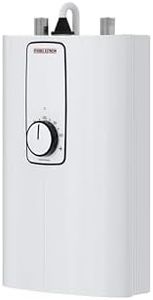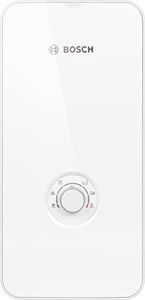We Use CookiesWe use cookies to enhance the security, performance,
functionality and for analytical and promotional activities. By continuing to browse this site you
are agreeing to our privacy policy
10 Best Electric Tankless Water Heaters
From leading brands and best sellers available on the web.By clicking on a link to a third party's website, log data is shared with that third party.
Buying Guide for the Best Electric Tankless Water Heaters
Choosing an electric tankless water heater is about finding the right balance between your household's hot water needs and the features that ensure performance and efficiency. These units only heat water when you need it, making them space-saving and energy-efficient compared to traditional tank water heaters. To make the best choice, it's important to consider your household size, the number of appliances or fixtures you want to supply, and your installation setup. Understanding the key specs and what they mean will help you select a unit that reliably provides enough hot water without overbuying or underestimating your demands.Flow Rate (Gallons Per Minute - GPM)Flow rate measures how much hot water the heater can deliver per minute, typically presented in gallons per minute (GPM). This is crucial because it determines how many showers, sinks, or appliances you can use simultaneously without running out of hot water. A lower flow rate (1–2 GPM) suits small needs like a single sink or occasional use, medium rates (2–4 GPM) can handle one shower and a sink at the same time, while higher rates (4+ GPM) are better for larger households with multiple simultaneous demands. Think about which fixtures you want to use at the same time, add up their typical water needs, and choose a unit with a flow rate that matches or slightly exceeds this demand.
Power (kW/Amperage Requirements)The power rating, expressed in kilowatts (kW) and the electrical amperage required, indicates how much electricity the heater uses to warm water. Higher kW means the unit can heat more water faster, but it also requires a stronger electric supply. Lower-rated (12–18 kW) units are for small households or single points, mid-range (18–27 kW) units handle average daily needs, and high-power (27 kW and above) units serve larger homes or higher demands. Consider both your household's hot water needs and your home's electrical capacity to ensure compatibility and performance without overloading your system.
Temperature RiseTemperature rise tells you how much the heater can increase water temperature as it passes through. This is especially important if you live in a cold climate where incoming water is chilly. For very cold ground water, you’ll need a unit capable of a higher temperature rise to provide comfortable hot water at your taps. Assess the average incoming water temperature in your area and select a heater that can raise it to your desired output temperature at your expected flow rate.
Activation Flow RateActivation flow rate is the minimum water flow required to trigger the heating element. A lower activation flow is ideal for places where you might use low-flow faucets or want hot water quickly with minimal waiting. If the activation flow rate is too high, you might find that the water doesn't heat up for light use. Consider your faucets and how you use hot water—the lower the activation rate, the more likely you’ll get hot water even during gentle use.
Size and InstallationTankless water heaters are compact but still come in various sizes. The size determines where you can install the unit—some are designed for whole-house use, while others fit under sinks or in tight spaces for single points. Think about your available space and whether you want a centrally located or a point-of-use unit, ensuring there's enough clearance and proper electrical access.
Energy Efficiency (EF/UFE)Energy efficiency ratings, like Energy Factor (EF) or Uniform Energy Factor (UFE), show how effectively the unit turns electricity into hot water. Higher efficiency means less wasted electricity and lower utility costs over time. If your priority is long-term savings and environmental impact, look for high-efficiency ratings to ensure you're making the most of each unit of energy consumed.

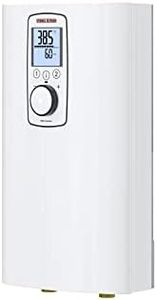
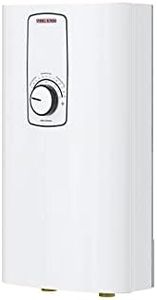
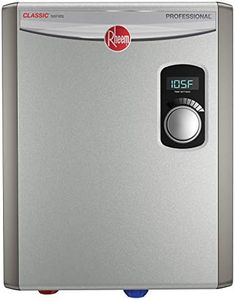
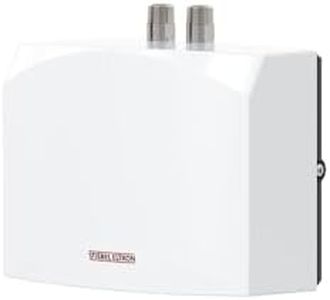
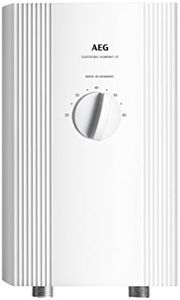
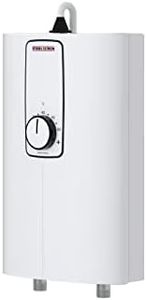
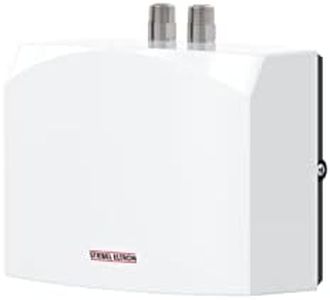
![Bosch Tronic 4000 6 EB Electronic Small Instantaneous Water Heater with Fixed Connection, Energy Class A, 6 kW [Energy Class A]](https://images-proxy.bestreviews.guide/aftI5wpYekcCERFSYWcX7OFkxxo=/0x300/https://m.media-amazon.com/images/I/31mdg7v4qaL._AC_CX679_.jpg)
